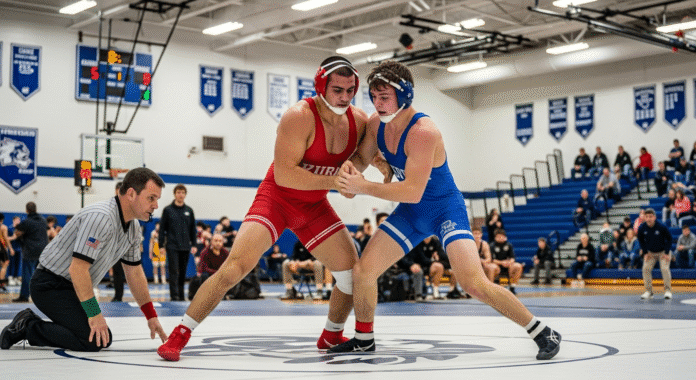A New Era for High School Wrestling: More Opportunities, New Challenges
In a bold move set to reshape high school wrestling in New York, the NYSPHSAA Central Committee voted to add a 14th weight class for boys starting in the 2025-26 season. This decision immediately addresses long-standing gaps in weight distribution while aligning the state with national standards. By creating more opportunities for student-athletes and helping schools field competitive teams, the change promises to boost participation and enhance fairness. Yet, as with any significant transition, it brings with it both promise and challenges that demand careful consideration.
Official Announcement and Rationale
New Structure for Increased Fairness
The NYSPHSAA has restructured its weight classes to include the following categories: 103, 110, 118, 126, 132, 138, 144, 150, 157, 165, 175, 190, 215, and 285 pounds. This move aims to:
- Increase athlete participation, particularly in middleweight divisions
- Narrow the wide gap between previous classes (for example, between 170 and 190 pounds)
- Preserve vital lower weight classes for smaller athletes
The NYSPHSAA Wrestling Committee explained, “New York’s 13 weight classes have been an outlier compared to other associations in the National Federation purview. Fourteen classes are the norm across most of the country.” This statement underscores the committee’s focus on aligning with national standards while addressing the unique needs of New York’s wrestling community.
Goals Behind the Change
This decision comes at a time when wrestling faces national challenges. Recent years have seen adjustments in weight class structures across the country, with many states adopting 14 classes to improve competitive fairness. In New York, the change is expected to:
• Encourage more student participation by offering a class that better matches athletes’ natural body weights
• Reduce instances of mismatched competitions that can lead to injuries or disputes
• Strengthen overall state performance by ensuring that every athlete has a fair chance to compete
Impact on Student-Athletes
More Opportunities and Greater Inclusivity
For high school wrestlers, the addition of a new weight class means more tailored opportunities on the mat. Athletes who previously found themselves squeezed between weight categories can now compete in a division that more closely fits their physique. Smaller athletes, in particular, benefit from the preservation of the 103-pound class, ensuring that they are not forced into higher weight brackets that may not suit their body types.
Coach Shaun Neely of Niskayuna remarked, “This change could help teams struggling to fill rosters and reduce forfeits during dual meets.” His perspective echoes a widespread sentiment that increased class categorization will allow for more balanced competition.
Enhanced Competition and Safety
The restructuring not only boosts inclusivity but also improves safety. By reducing extreme differences in weight between competitors, the new divisions aim to mitigate injury risks and promote fairer matches. The rebalancing of weight classes directly addresses the previously wide gap between certain divisions, such as the jump from 170 to 190 pounds, making matchups safer and more competitive.
Reactions from the Wrestling Community
Support Among Coaches and Organizations
Many coaches and organizations have applauded the decision. They see the 14th weight class as a much-needed step to modernize the sport in New York. Wrestling organizations have emphasized that aligning with the national trend is beneficial not only for fairness during competitions but also for preparing student-athletes for regional and national events.
Local committees agree that the change will likely drive increased participation. With more weight classes, more athletes can find a category that suits their body type and skill level. This shift is viewed as an effort to create a more diverse and competitive landscape in high school wrestling.
Concerns and Practical Challenges
Despite the support, there are valid concerns. Some school athletic directors and coaches point to several potential drawbacks:
• Scheduling Challenges: With an extra weight class, tournaments and dual meets might run longer, potentially causing conflicts with other school events and taxing limited facility resources.
• Increased Costs: Schools may incur additional expenses related to staffing, equipment, officiating, and longer travel distances if tournaments extend over multiple days.
• Fielding Competitiveness: Smaller schools with limited rosters might struggle to fill all 14 classes. This could result in more forfeits and uneven competition between schools.
It is important that these concerns be addressed through proactive planning and resource allocation. Wrestling officials are working on guidelines to help schools manage the transition effectively while ensuring fairness and sustaining strong competitive standards.
Broader Implications and National Trends
Aligning with National Standards
Around the country, similar shifts in weight classification have helped improve participation and maintain competitive balance. Most states under the National Federation of State High School Associations have standardized on 14 weight classes. For New York, adopting this model brings the state in line with national norms and sets a foundation for improved performance at the regional and national levels.
Participation Trends and Financial Impact
Recent statistics indicate that high school wrestling nationally has experienced a decline in participation, by nearly 9% over a decade. However, regions with more inclusive weight structures have noted slower declines or even modest increases in athlete numbers. Financially, the expanded weight classes may also boost revenue at tournaments as increased attendance and competitive balance drive higher engagement.
Gender Equity Considerations
While the decision benefits boys’ wrestling by increasing the number of classes, it raises important questions about gender equity. Girls’ wrestling in New York continues with 13 weight classes. This discrepancy may prompt further discussion among advocates seeking similar opportunities for female athletes, ensuring balanced support across all high school wrestling programs.
Addressing Counterarguments and Concerns
Scheduling, Costs, and Logistical Challenges
Adding a weight class inevitably stretches the timetable of wrestling meets. Longer tournaments mean athletes and coaches must adapt to extended periods on the mat. Schools may also face logistical challenges, including coordinating additional officials and ensuring adequate preparation time for extended competitions. These factors might lead to increased operational costs that could burden smaller schools with limited budgets.
Competitive Fairness and Talent Distribution
Critics caution that while increasing the number of weight classes provides more options, it may also dilute the talent pool. With athletes spread more thinly across the divisions, some weight classes may experience less competitive matches. Furthermore, the frequent adjustments to weight categories over the past few years have been viewed by some as contributing to instability. New York has seen shifts from 15 to 13 weights and now to 14, a cycle that could unsettle the strategies of long-standing programs.
Expert Insights and Community Feedback
Experts suggest that while the change is in line with national practices, the practical realities of New York’s diverse school sizes and resource availability must be addressed. Wrestling officials and community leaders emphasize the need for robust communication and support strategies during the transition period. As one regional official noted, “We must ensure every school, regardless of size, receives guidance to implement these changes effectively so that no athlete is left behind.”
Looking Ahead: What to Expect in the 2025-26 Season
Preparing for Change
As the new academic and athletic season approaches, schools across New York are gearing up for the expanded roster of weight classes. Athletic departments are rethinking recruitment strategies and preparing their facilities for longer meets. Coaches are undergoing training sessions to familiarize themselves with the new structure and to devise strategies that leverage the opportunities created by the additional weight class.
Community Engagement and Ongoing Evaluation
The transition to 14 weight classes is not only a structural change but also a community effort. Wrestling organizations, schools, and local communities are encouraged to collaborate closely during the implementation phase. Continuous feedback from athletes, coaches, and spectators will be essential to ironing out unforeseen challenges. It is a dynamic process, and community voices remain integral in ensuring that the new system truly benefits every stakeholder.
A Call to Action
As New York steps into this new era of high school wrestling, athletes, coaches, and fans are invited to voice their opinions and participate actively in the conversation. Whether you are a parent, a coach, or a dedicated wrestling spectator, your input can help shape how these changes unfold. Join your local meetings, share your experiences, and contribute ideas on how to make the transition as smooth and beneficial as possible.
“The change is designed to increase participation for middle weights, preserve a lower weight class, and address the wide gap between 170 and 190 pounds.”
— NYSPHSAA Wrestling Committee (ArmDrag)
The NYSPHSAA’s decision to add a 14th weight class in high school boys’ wrestling is more than a rule change; it is set to redefine competitive fairness and athlete opportunities in New York. By aligning with national standards, the new structure promises to boost participation, enhance safety, and prepare athletes for higher levels of competition. At the same time, the transition comes with logistical and financial challenges that warrant careful planning and community support.
Now is the time for schools, coaches, and community members to come together and ensure that every athlete benefits from these changes. Share your thoughts and insights, and help contribute to a future where high school wrestling continues to thrive. Get involved, stay informed, and let your voice be heard as New York prepares for a new chapter in high school sports.




